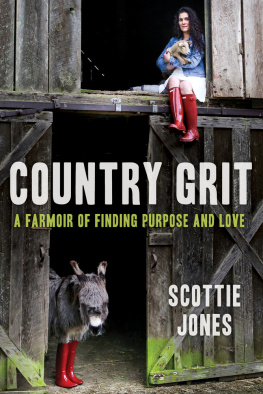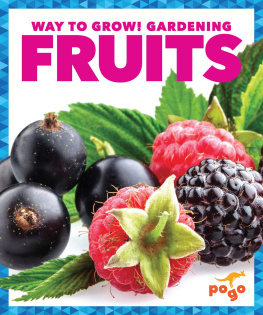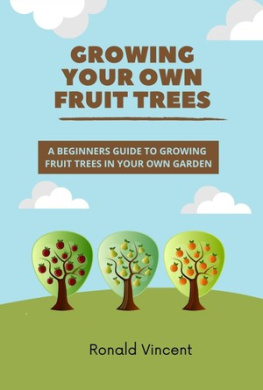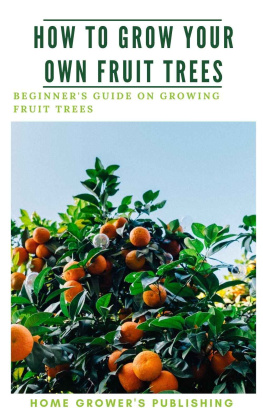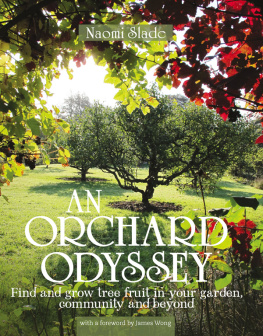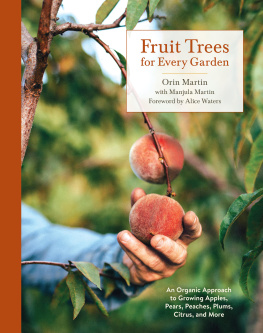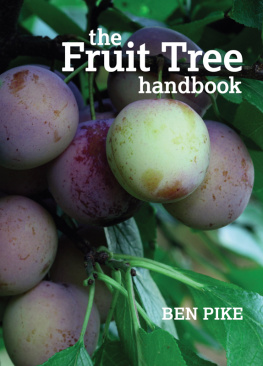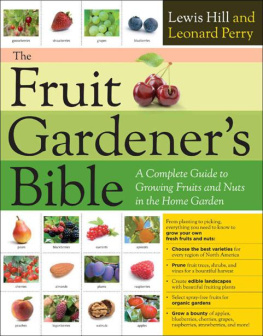How To Grow Fruit Trees For Beginners: Complete Guide For Growing Delicious Fruit
Amanda Jones
Published by Amanda Jones, 2015.
While every precaution has been taken in the preparation of this book, the publisher assumes no responsibility for errors or omissions, or for damages resulting from the use of the information contained herein.
HOW TO GROW FRUIT TREES FOR BEGINNERS: COMPLETE GUIDE FOR GROWING DELICIOUS FRUIT
First edition. July 16, 2015.
Copyright 2015 Amanda Jones.
ISBN: 978-1516301690
Written by Amanda Jones.
10 9 8 7 6 5 4 3 2 1
Introduction
T hank you for downloading this book, How to Grow Fruit Tree Properly
Money if truth be told can grow on trees! Reduce your grocery bills while improving your backyard by planting and growing fruit trees.
Planting fruit trees are a great approach to save money, revamp your backyard and keep a supply of fresh, healthy fruit at hand. Investing in a fruit tree is a win-win proposition. You will not only put aside money, but your family will develop health, enhance your landscape, and have reasonable growth of your own provisions. In addition grocery store fruits are particularly flavorless in comparison to your own home grown harvest.
In this eBook you will find a comprehensive guide on how to grow fruit tree properly. Hope you find the gardening tips and tricks recommended helpful in yielding an abundant harvest.
Chapter: 1 Choosing Fruit Plants and Trees
A fruit tree and plant requirements need to be well thought-out in detail ahead of planting, and should structure part and overall plan, and the ambiance of your garden. Choose fruit trees that are effortless to grow in your region and which you and your family are pleased to devour.
Apples, Cherries, Plums, Pears are among the finest choice for home gardens. If you select disease-resistant variety, they involve modest spraying or fuss that marketable growers lavish on trees to guarantee the biggest, ideal store ready fruits. You can come across disease-resistant range of fruit by getting in touch with your government-funded local cooperative extension service. Or, simply use Google.
Fruit trees for a smaller land area
I f you do not have enough space you could still grow trees in your backyard. Dwarf trees or citrus fruit trees are considerably easy to grow and do not take up a lot of space once full grown. These trees can be planted in large sturdy pots additionally. For those who have a large yard could plant orchard trees such as apples, pears, peaches. Finding a fruit tree is not like one size fits all. You need to understand the requirements of the plantation and the climate in your region and the space it requires, especially when it matures.
The climate in your garden
W hat type of climate is your garden exposed to? A tree or plant flourishes under dissimilar surroundings. Ensure that you opt for an array of fruit plants and trees that can survive the climate. Be careful and avoid freezing a tender a sapling or dehydrating a plant that blossoms in cooler climates.
Planning planting fruit trees
T he preferred time to plant fruit trees or plants is from late-autumn to early spring when temperatures are cooler. To find the finest range to use in your neighboring vicinity, check with the nurseries. The foremost requirement to grow a fruit tree is direct sun at least eight hours of unfiltered light each day.
Space obtainable for fruit trees
S ome varieties of fruit plants and trees will grow for decades and enhance in size significantly. Some trees are undersized and wider, others are elevated and slender. Consider the dimension at maturity and the effect it will have on the garden and house will it shade another plant or tree, will the roots cause damage to the foundation. In addition think about the abundance of fruit or exquisiteness of plants in that space. There are fundamentally three types of trees; Dwarf trees grow up to ten feet tall and produce possibly a bushel or so of fruit depending on the kind of year. Semi-dwarf trees group up to fifteen feet tall and produce fruits in hundreds. Full-sized trees develop to be thirty feet tall and produce and awe-inspiring quantity of fruit at maturity.
For home gardens, semi-dwarf and dwarf trees are favored and are easier to harvest.
How much time can you contribute to gardening?
S ome varieties of fruit plants and trees involve least maintenance, while others such as apples and grapes, need ongoing care. Think about the year forward and how much time you could spare to gardening. Think about your fruit harvest do you require quality fruits or large yields. Younger fruit trees produce larger yields; nevertheless they need devoted fostering as they then to be more fragile. Grown-up fruit trees are more hardly and resistant to disease. However, they require attention too, though not as much as the younger trees.
Chapter: 2 Type of Soil for Growing Fruit Trees
T he right type of soil will ensure healthier growth and a plentiful amount of fruit production. In general, fruit trees grow finest in soils with excellent drainage and ample of nutrients.
Ideal Soil
F ruit trees grow finest in well-drained soil with a sandy, loamy texture. They in addition require deep soil to sustain their root systems. Heavy clay soils, soils deficient in nutrients or overly rocky soils can stun tree development.
Soil Testing
N early all fruit trees need a soil pH balance of about 6.0 and 6.5. In case you are doubtful about the nature of soil in your backyard, it is useful to put together a soil sample and get it tested in a local or nursery or laboratory. A lab will be able to offer recommendations as to whether the soil requires pH testing adjustments or supplementary nutrients. If you just want to test pH, basically use pH testing strips obtainable online and at several gardening supply stores.
Soil Improvement
I f soil tests reveal more than usually acidic pH, adding together some lime can help elevate the pH and make it more suitable for fruit trees. Alternatively, sulfur lowers the soil pH if it is not acidic enough, since dissimilar soil additives come in different concentrations, cautiously follow manufacturing instructions, and vigilantly administer the soil to a prcised pH level.
Clay soils in some regions have several nutrients along with poor drainage. Gardeners with clay soils may not require adding a great deal fertilizers, but they can add a quantity of compost to perk up drainage. On the other end of the spectrum, a layer of mulch over the surface of soil will aid overly sandy soil retain moisture. Springtime applications of a balanced fertilizer will facilitate to modify soil with lower levels of nutrients.
Potted Fruit Trees
Y ou may decide on growing potted fruit trees in commercial potting soil. You may as well mix sand, perlite, and peat or bark in equivalent proportions to make a potting blend. Be certain to use a combination that has exceptional drainage while still retaining plenty of moisture for the tree roots. To further smooth the progress of drainage, opt a pot with large drainage holes, line up the bottom of the pot with screen, and lay a layer of gravel at the base of the pot.
C hapter: 3 Preparing the Fruit Tree
Avoid planting trees during frost. Place roots in moist soil until environmental conditions improve. Soak the roots before planting. Bare-root trees should be planted towards the end of autumn to early winter as this is when the tree is in its dormant phase. Container-grown trees can be planted at anytime of the year, except for when frosty or if the ground soil is parched or too soggy.





